Types of Hornets: Nest, Size, Color (With Pictures) – Identification Guide
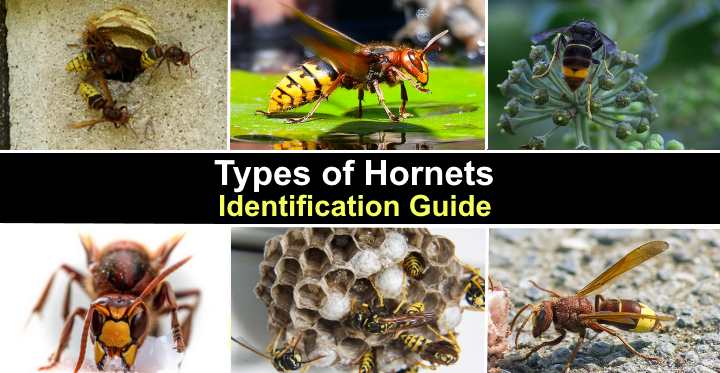
A hornet is a kind of giant wasp with brown and yellow stripes and a black or yellow body. Hornets have venom-containing stingers that can deliver a painful and, sometimes, life-threatening sting. Asian species of hornets—Asian hornet and Japanese giant hornet—have a reputation for being aggressive. However, the European hornet can also attack humans if you get too close to the hornet nest. Hornets are social flying insects that live in papery nests.
Knowing how to identify hornets is essential to distinguish between potentially harmful insects and docile ones. Additionally, learning about the habitat of hornets can help you know if you have problems with hornets in your garden or house.
This article is an identification guide to the most common types of hornets you could find buzzing around your garden.
Facts About Hornets
Hornets belong to the insect genus Vespa and family Vespidae and are related to wasps. Hornets have an identifiable large head with a wide top margin. In addition, there is a noticeable large gap between the thorax where the two sets of wings are located and the abdomen. Depending on the species, hornets can have yellow and brown stripes or dark-colored with orange bands.
Although hornets can be aggressive insects, they tend only to attack if the nest is under threat. However, an attack of Asian giant hornets can have severe consequences. Hornets release an attack pheromone that mobilizes other hornets in the nest. In addition, dead hornets or the scent of dead hornets on clothes can also trigger a severe hornet attack.
Hornets feed on sugar-rich plant foods, oak tree sap, honey, or rotting fruits. Adult hornets also attack other insects such as grasshoppers, bees, katydids, and locusts. The venomous hornet sting is strong enough to kill large insects quickly.
Hornets (Vespa) shouldn’t be confused with the similar-looking North American yellowjacket (Dolichovespula maculata). Sometimes called the bald-faced hornet, the yellowjacket belongs to a different genus; however, it is related to hornets in the family Vespidae.
Hornets vs. Wasps
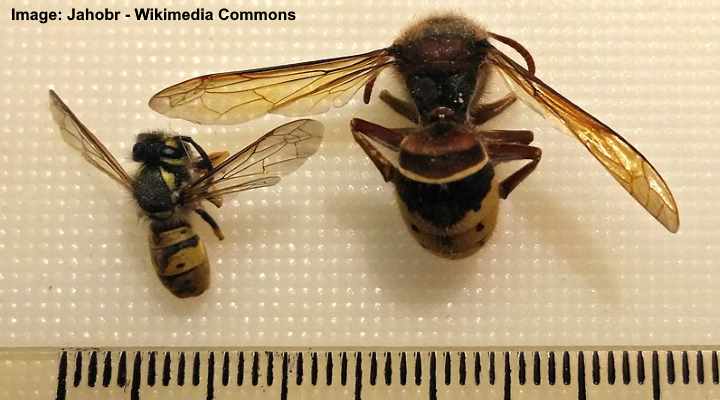
Size comparison of wasp (left) and hornet (right)
The primary difference between hornets and wasps is size and color. Most wasps tend to be around 0.4” (1 cm) long. However, giant hornets can be over 1.6” (3.8 cm) long, with queen hornets as huge as 2” (5 cm) in length. Interestingly, compared to wasps, the European hornet is less aggressive.
Hornet Nest
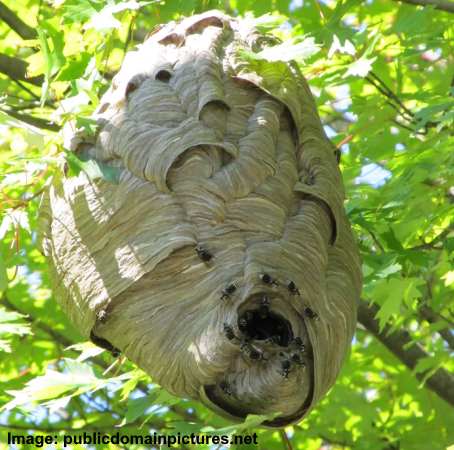
Hornet nest
Hornets typically prefer to build nests high up in tall trees, hollow trunks, large shrubs, or rooftops. However, some hornets construct subterranean nests in abandoned burrows or shaded dry areas. They construct the papery nests by chewing on woody material.
Hornet nests look like a gray globular or conical papery structure with a single entrance. If you spot a hornets’ nest in a tree, attic, under a roof overhang, or eaves, you should never attempt to remove the nest. Instead, it’s best to call in the experts to get rid of a hornets’ nest.
Hornet Size
Hornets are giant wasps that grow between 1.5” and 2” (3.8 – 5 cm) long. Queen hornets are the largest of the species. They can be over 2” (5 cm) long. Typically, worker hornets are smaller and measure 1.4” to 1.6” (3.5 – 3.8 cm) in length. A hornet’s wingspan is 3” (7.5 cm). Its venomous stinger is 0.25” (0.6) long.
Hornet Colors
Hornet colors depend on the species.
The common European hornet (Vespa crabro) has red and brown markings on a dark thorax. Its body is mainly yellow with thin brown stripes and markings.
Asian giant hornets (Vespa mandarinia) are darker in color. They have a mainly orange head and a dark brown thorax. Their abdomen is dark brown with orange bands around the long body. The Asian hornet (Vespa velutina) is also dark in color but with a mainly dark, stripe-less abdomen.
Hornet Sting
Hornets have a highly venomous sting that is five times more potent than a wasp’s sting. The venom in a hornet’s sting contains 5% acetylcholine—enough to kill small mice. In some cases, a sting from a hornet can cause allergic reactions, resulting in organ failure and even death.
In 2019, Asian giant hornets were discovered in the US. The discovery of this highly venomous hornet species gave rise to headlines such as “murder hornet invasion.” However, doctors say that ‘murder hornet’ attacks are rare and only if the nest is threatened. Because of the risk of allergic reactions, it’s best to seek medical advice if a hornet stings you.
How to Identify Hornets
Hornet identification is usually by their size. Hornets are giant 1.5” to 2” (3.8 – 5 cm) flying insects that look like massive wasps. Hornets have a distinctive head with a relatively large top margin. You can all tell a hornet by its dark upper body and yellow-striped abdomen.
Suppose you see a colossal wasp as long as your thumb flying around and can hear its loud, buzzing wing movement. In that case, the chances are that it’s a hornet, not a yellowjacket or wasp.
Type of Hornets with Names and Pictures (Including Identification Guide)
In the United States, European hornets are relatively common, whereas Asian hornets are relatively rare. Let’s look at how to identify species of hornets.
Asian Giant Hornet or Japanese Giant Hornet (Vespa mandarinia)
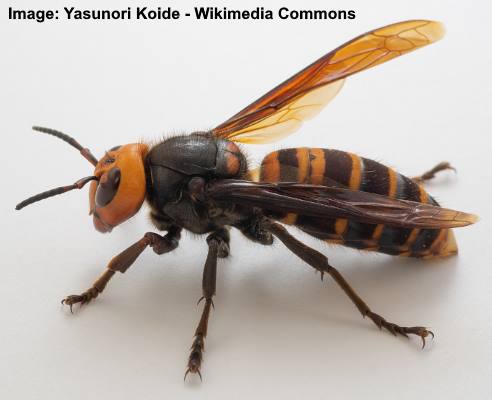
Asian / Japanese Giant Hornet (Vespa mandarinia)
The Asian giant hornet is the largest hornet and the species that has the name “murder hornet.” Also called the Japanese giant hornet, the insect has a large orange head, dark brown thorax with orange patterns, and brown abdomen with orange stripes.
Other identifying features of the Asian giant hornet are two brown antennae, dark brown or black eyes on an orange head, and large orange wings with a wingspan up to 3” (7.5 cm). You’ll also notice six brown legs.
These “murder hornets” prey on other insects and often kill colonies of honeybees. The hornet uses large mandibles to decapitate bees quickly. The “murder hornet” can kill as many as 40 bees per minute. However, the giant wasps will also feed on tree sap, honey, nectar, and soft fruits.
Asian giant hornets have a stinger 0.23” (0.6 cm) long. The venom in the stinger is the same as bee and wasp venom, only more concentrated. The sting of a single Asian giant hornet can feel like a hot nail being driven through the skin. Although a single hornet sting is rarely deadly, multiple stings can be fatal.
Until 2019, the Asian giant hornet was mostly confined to Japan, China, and Asia. However, sightings of Asian giant hornet nests in Washington state confirmed that the species could become invasive in the US, where they were called “murder hornets.” This hornet species isn’t found in Europe.
Asian Giant Hornet Size: Queen hornets are over 2” (5 cm), and worker hornets are 1.4” to 3” (3.5 – 7.5 cm).
Asian Giant Hornet Nest: The hornets make nests high up in trees or rooftops. Or they can find abandoned burrows and create underground nests. Nests can be up to 20” (50 cm) in diameter.
Asian Giant Hornet Color: Orange head, black or brown thorax with reddish-orange markings, and a brown and orange striped abdomen.
Hornet Identification: An Asian giant hornet has an identifiable large striped body with orange wings and a large orange face with brown compound eyes.
Asian Hornet (Vespa velutina)
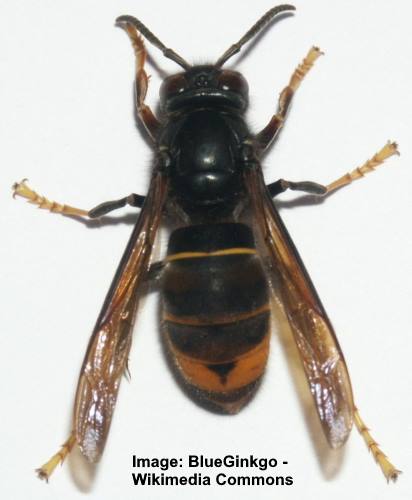
Asian Hornet (Vespa velutina)
The Asian hornet is a small hornet with a mainly dark brown or black head, thorax, and body with dark yellow or orange bands on its abdomen. Additionally, Asian hornets have distinctive yellow legs. Asian hornets live in nests that can hold thousands of flying insects.
Also called the yellow-legged hornet, the Asian hornet shouldn’t be confused with the larger Asian giant hornet. However, like the larger species, the Asian hornet is a predatory insect that preys on honeybees. For example, a hornet will hover near a bees’ nest and catch a bee returning to the hive.
Asian hornets also prey on flies, dragonflies, cricket, grasshoppers, and locusts.
Like all insects in the genus Vespa, Asian hornets construct nests by making paper from chewed wood and their saliva. Typically, Asian hornets build nests high up in trees, under eaves, or rooftops. There can be up to 6,000 Asian hornets in a single nest.
As their name suggests, Vespa velutina hornets are native to Asia. However, they have become an invasive pest in many European countries such as the United Kingdom, Spain, France, Portugal, and Belgium. The worry for beekeepers is that yellow-legged hornets are an invasive predator that can quickly kill honeybee populations.
Asian Hornet Size: Queen hornets are 1.2” (3 cm) long, and workers are 0.8 (2 cm) in length.
Asian Hornet Nest: The hornets build large papery, egg-shaped nests up to 20” (50 cm) long.
Asian Hornet Color: Predominately velvety dark brown with orange markings on the abdomen.
Hornet Identification: An Asian hornet has a distinguishable dark-colored abdomen with thin yellow stripes and a broad orange band at its base. Asian hornets are identifiable from other hornets due to their yellow legs.
Asian hornets are one of the many insects that look like bees.
European Hornet (Vespa crabro)
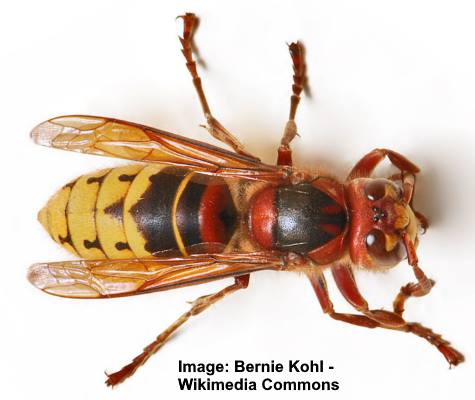
European Hornet (Vespa crabro)
The European hornet is a giant striped yellow and brown wasp common in Europe and North America. European hornets have an identifiable dark orange head, a dark brown thorax with orange markings, and a yellow abdomen with black or brown bands.
Also called the brown hornet or giant hornet, the species shouldn’t be confused with Asian species. Although large, the European hornet is slightly larger than the Asian hornet but not as massive as the “murder hornet,” or Asian giant hornet. European hornets look more like yellowjackets than Asian hornets.
European hornets typically build nests in protected areas. So, you are more likely to find the hornets’ nest in an attic, barn roof, tree hollow, or wall void rather than hanging high up in a tree. In addition, the papery structures are not as large as the Asian species and usually hold between 300 and 500 hornets.
European hornets feed on soft fruits, tree sap, nectar, and honey. They will also hunt small insects like moths, dragonflies, beetles, and wasps. Although European hornets will kill honeybees, they are not a threat to bees like Asian hornets are.
Like all species of wasps, European hornets have venomous stingers. They will sting a person if they feel threatened or disturbed. However, European hornets are not generally aggressive, and their sting isn’t as serious as Asian hornets.
European Hornet Size: Queen hornets are 1.4” (3.5 cm) in length, and workers are 1” (2.5 cm) long.
European Hornet Nest: The hornets build papery nests in tree hollows, wall voids, inside barns. Unlike Asian hornets, the European species rarely builds nests in unprotected areas.
European Hornet Color: Primarily yellow in color with dark brown bands around their abdomen.
Hornet Identification: The European hornet is identified as a giant yellow wasp with a striped body, dark brown thorax with rusty orange markings, and an orange face with large eyes in relation to the head size. Other identifying features are six reddish-brown legs, orange antennae, and transparent light brown to orange wings.
Yellow Hornet (Vespa simillima)

Yellow Hornet (Vespa simillima)
The Japanese yellow hornet is a yellow and dark brown striped flying insect with extended wings, orange legs, and two brownish-orange antennae. Yellow hornets are smaller than the typical Asian hornet species. Queen hornets are 1” (2.5 cm) long, and workers are typically 0.8” (2 cm).
Yellow hornets produce papery nests and are common in wall voids, attics, and other protected places. Like all hornets, the yellow species feeds on sap or nectar and will also attack smaller insects.
A feature of yellow hornet behavior is that they swarm in large numbers, sometimes up to 2,000. This means that a yellow hornet attack can be more severe than an Asian giant hornet sting as giant hornets swarm in fewer numbers, resulting in fewer stings.
Hornet Identification: A yellow hornet has an easily identifiable yellow abdomen with dark brown bands around it.
Oriental Hornet (Vespa orientalis)
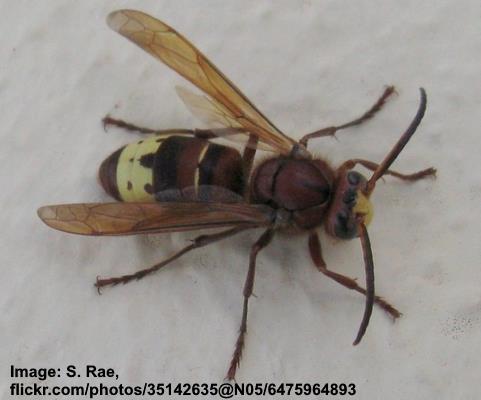
Oriental Hornet (Vespa orientalis)
The oriental hornet is a small reddish-brown hornet with distinctive yellowish bands at the base of its abdomen. Other identifying features are transparent light brown wings, six brown legs, and a fuzzy thorax. Smaller than Asian hornets, the oriental hornet measures between 1” and 1.4” (2.5 – 3.5 cm) long.
You will typically find oriental hornets in underground nests. However, they sometimes build papery nests in tree hollows.
Hornet Identification: To identify an oriental hornet, look for the recognizable thick yellow bands on its abdomen and yellow markings between its eyes.
Black-Tailed Hornet (Vespa ducalis)
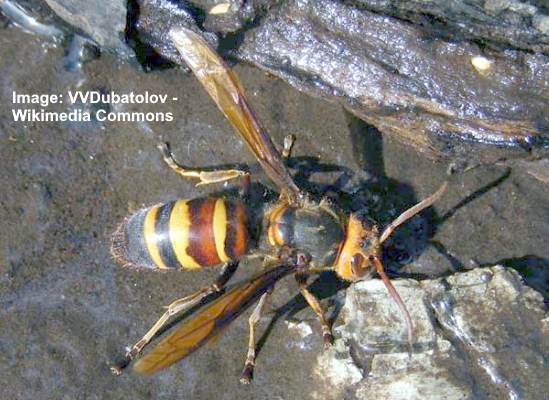
Black-Tailed Hornet (Vespa ducalis)
The black-tailed hornet is a large flying insect with a banded abdomen of yellow, brown, and black colors. Black-tailed hornets also have an orange head with dark brown eyes. Queen hornets measure 1.5” (4 cm) long, and workers are 1.2” (3 cm) in length.
Black-tailed hornets create small underground nests, with only about 50 individuals inhabiting them.
Hornet Identification: You can identify a black-tailed hornet by the yellow and brown bands around its abdomen and distinctive black tail. Also, look for its long brown wings and six yellow and brown legs.
Vespa soror
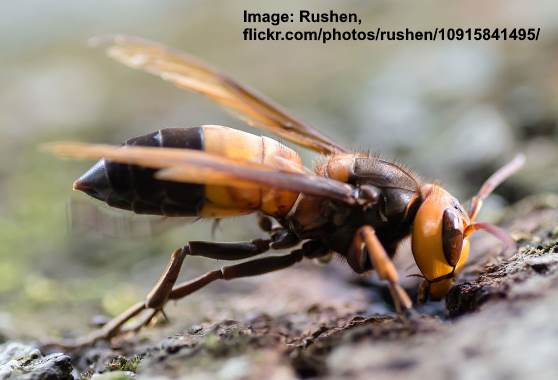
Vespa soror
The Vespa soror is a large hornet native to Asia. It is identified by its light orange and brown body, black fuzzy thorax, pale orange wings, and yellow or orange head with two long antennae. Queens measure 1.5” (4 cm) long, and the workers measure 1.4” (3.5 cm).
Vespa soror hornets feed on sweet substances and prey on honeybees, wasps, dragonflies, mantids, and grasshoppers.
Hornet Identification: Vespa soror is easy to identify due to its distinctive two bands around its body—one black and the other orange with brown markings. The black thorax has an orange patch at its base. A widened yellowish-orange head makes the eyes appear relatively small. You’ll notice that the lower legs may also appear pale orange.
Greater Banded Hornet (Vespa tropica)
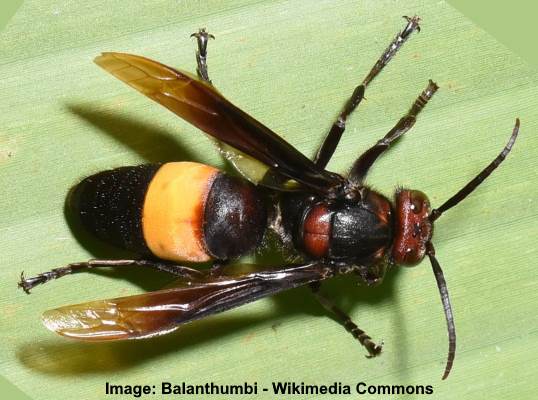
Greater Banded Hornet (Vespa tropica)
The greater banded hornet is a relatively small hornet with a dark brown head, black thorax, and black abdomen with a distinctive wide yellow band. Greater banded hornets measure around 1” (2.5 cm), and the queens are 1.2” (3 cm) long.
The hornets feed on wasp and honeybee larvae and even catch and kill honeybees.
Greater banded hornets create large egg-shaped papery nests 10 ft. (3 m) in trees and shrubs above the ground. They may also build nests in attics, rooftops, sheds, and underground burrows. Depending on the location, some greater banded hornets can be completely black.
Hornet Identification: The greater banded hornet has an easily identifiable wide yellow band around its black abdomen. The hornet has a distinctive dark copper-colored head, black thorax with dark brown markings, and six black legs.
Related articles:
